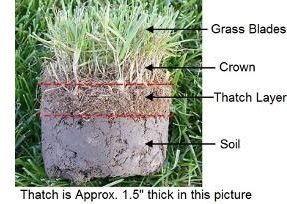What is DeThatching?
DeThatching is also commonly referred to as “Thatching“ as well as “Power Raking”. “Thatch” is a build-up of organic matter made up of grass clippings, leaves, stems etc. Dethatching involves removing the excess layer of thatch from your lawn that can lead to several issues. A side benefit can be the partial removal of moss which gives your grass a higher chance of filling back in. Dethatching can be performed by using a hand rake or a power rake/thatcher.

A hand rake may work for very small areas, although it is often less effective at removing thatch. It’s also very time-consuming. Power rakes or dethatchers are far more efficient and incredibly effective if properly done. The dethatcher blades/tines can be adjusted higher or lower, depending on your lawns needs. Keep in mind, it’s better to have them too high than too low. They can cause damage to the roots of your grass if set to an improper height. There are also attachments or blades that can be added to your lawn mower. These are not recommended though, because they are not very effective. Its best to use a machine designed specifically for removing thatch. Dethatching is typically one of the fundamental aspects of any spring clean up service.
Thatch: Beneficial or Detrimental?
Thatch can either be beneficial or detrimental to your lawn, depending on the thickness of the thatch buildup. A thin layer of thatch (less than 1/2 inch thick) can be beneficial. This is because it helps to limit weed germination, reduce water evaporation, and protect from frost damage. When it gets thicker than 1/2″, it can prevent water & oxygen from reaching the root, can choke out the grass & it can act as a harbor for pests to thrive. Significant thatch buildup in lawns can cause diseases and can encourage moss to grow in the areas where grass has died.
How Can I Slow Down the Buildup of Thatch?
The overall health of your lawn plays a substantial role in thatch buildup. Over fertilization (specifically Nitrogen) can greatly accelerate the natural buildup of thatch. Avoid frequent & shallow watering on established lawns (causes roots to stay close to the surface). Instead, water deeply & less often, as this encourages healthy root development. Despite the common perception, allowing grass clippings to remain on the lawn doesn’t contribute to thatch. Grass clippings break down quickly and encourage the beneficial earthworms and microorganisms. One of the most common mistakes made is cutting the grass too short. Kentucky Bluegrass (Anchorage’s most common grass) does best when the lawn is mowed at a height of 3.5″. Having your lawn Aerated on an annual basis with an aerating machine can be very beneficial. These pull plugs from the lawn and can drastically improve both the quality of your lawn and reduce thatch buildup.
How Often Should My Lawn be Dethatched?
This varies widely depending on the variety of grass, the climate, and the overall health and maintenance of your lawn. The most common variety of grass found locally in Anchorage, Alaska is “Kentucky Bluegrass”. This cold weather grass variety is known to quickly build excessive layers of thatch. Dethatching is recommended annually in Anchorage during due to the combination of grass variety & cooler climate. Depending on the above variables, lawns are best thatched in either the fall, late spring, or early spring. In Anchorage, early spring is the best time to perform this lawn maintenance. Dethatching can be one of the most effective ways to revive or drastically improve the quality of your lawn. We include Power Raking as a part of our “Anchorage Spring Clean Up Services“.
